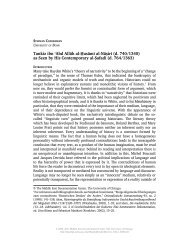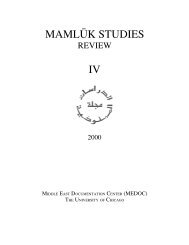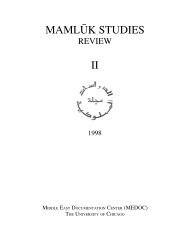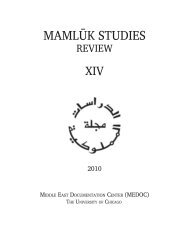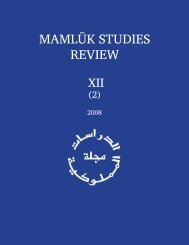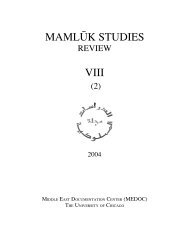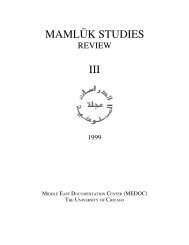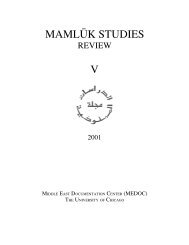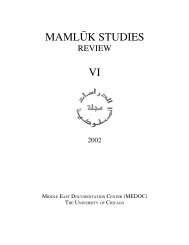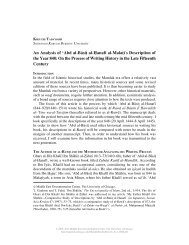It Has No Root Among Any Community That Believes in Revealed ...
It Has No Root Among Any Community That Believes in Revealed ...
It Has No Root Among Any Community That Believes in Revealed ...
Create successful ePaper yourself
Turn your PDF publications into a flip-book with our unique Google optimized e-Paper software.
WARREN C. SCHULTZ<br />
DEPAUL UNIVERSITY<br />
"<strong>It</strong> <strong>Has</strong> <strong>No</strong> <strong>Root</strong> <strong>Among</strong> <strong>Any</strong> <strong>Community</strong> <strong>That</strong> <strong>Believes</strong> <strong>in</strong> <strong>Revealed</strong><br />
Religion, <strong>No</strong>r Legal Foundation for <strong>It</strong>s Implementation":<br />
Plac<strong>in</strong>g al-Maqr|z|'s Comments on Money <strong>in</strong> a Wider Context<br />
I<br />
<strong>It</strong> is certa<strong>in</strong>ly noth<strong>in</strong>g new to state that the works of al-Maqr|z| have been one of<br />
the most important sets of resources used by scholars of the economic and monetary<br />
history of the medieval Middle East <strong>in</strong> general, and for the Mamluks <strong>in</strong> particular.<br />
His short treatises Igha≠thah and Shudhu≠r are well known for their focus on economic<br />
matters, and his chronicle the Sulu≠k and topographical work the Khit¸at¸, among<br />
others, also reflect the author's concern with these issues. 1 As a result, one can<br />
scarcely pick up an article or chapter about Islamic money without f<strong>in</strong>d<strong>in</strong>g the<br />
obligatory reference to Sauvaire's n<strong>in</strong>eteenth-century compilation of monetary<br />
and metrological citations, which conta<strong>in</strong>s more references to the works of al-<br />
Maqr|z| than any other author. 2 When it comes to the history of Mamluk Egypt,<br />
the reliance is even greater. This is clear if we exam<strong>in</strong>e the nuts and bolts of<br />
Mamluk monetary research. Citations to al-Maqr|z|'s many works are common <strong>in</strong><br />
the "Currency" section of William Popper's Systematic <strong>No</strong>tes to Ibn Taghrî Birdî's<br />
Chronicles of Egypt. 3 Paul Balog, the author Co<strong>in</strong>age of the Mamlu≠k Sultans of<br />
Egypt and Syria, relied primarily on French translations of some of al-Maqr|z|'s<br />
major texts for much of the historical context which he <strong>in</strong>cluded <strong>in</strong> his works<br />
©Middle East Documentation Center. The University of Chicago.<br />
1 Al-Maqr|z|, Kita≠b Igha≠that al-Ummah bi-Kashf al-Ghummah, ed. Muh˝ammad Mus˝t¸afá Ziya≠dah<br />
and Jama≠l al-D|n al-Shayya≠l (Cairo, 1940); Shudhu≠r al-‘Uqu≠d f| Dhikr al-Nuqu≠d, ed. Muh˝ammad<br />
‘Abd al-Satta≠r ‘Uthma≠n (Cairo, 1990), and many other editions; Kita≠b al-Sulu≠k li-Ma‘rifat Duwal<br />
al-Mulu≠k, ed. Muh˝ammad Mus˝t¸afá Ziya≠dah and Sa‘|d ‘Abd al-Fatta≠h˝ ‘A±shu≠r (Cairo, 1934–72);<br />
Al-Mawa≠‘iz˛ wa-al-I‘tiba≠r bi-Dhikr al-Khit¸at¸ wa-al-A±tha≠r (Bulaq, 1270).<br />
2 Henri Sauvaire, "Matériaux pour servir à l'histoire de la Numismatique et de la Métrologie<br />
Musulmanes," Journal Asiatique, 7 serie, 14 (1879): 455–533; 15 (1880): 228–77, 421–78; 18<br />
(1881): 499–516; 19 (1882): 23–77, 281–327; 8 serie, 3 (1884): 368–445; 7 (1886): 124–77,<br />
394–468; 8 (1886): 113–65, 272–97, 479–536. <strong>It</strong> is also worth not<strong>in</strong>g that Isaac de Sacy had<br />
translated al-Maqr|z|'s Shudhu≠r al-‘Uqu≠d at the end of the eighteenth century.<br />
3 William Popper, Egypt and Syria under the Circassian Sultans, 1382–1468 A.D.: Systematic<br />
<strong>No</strong>tes to Ibn Taghrî Birdî's Chronicles of Egypt, University of California Publications <strong>in</strong> Semitic<br />
Philology, no. 16 (Berkeley, 1957), 41–73.<br />
© 2003, 2012 Middle East Documentation Center, The University of Chicago.<br />
http://mamluk.uchicago.edu/MamlukStudiesReview_VII-2_2003.pdf
170 WARREN C. SCHULTZ, AL-MAQR|Z|'S COMMENTS ON MONEY<br />
about Mamluk numismatics. 4 Jere L. Bacharach, the first scholar to comb<strong>in</strong>e<br />
systematically the exploitation of Mamluk numismatic evidence with <strong>in</strong>formation<br />
derived from the many chronicles and other written sources, counted more than<br />
850 references to money and prices <strong>in</strong> the Sulu≠k for the period from 1382 up to<br />
the end of the chronicle alone. 5 These citations have been the grist for many other<br />
studies.<br />
Yet as any recent text on historical methods would po<strong>in</strong>t out, and as many of<br />
the papers of this conference have emphasized, us<strong>in</strong>g al-Maqr|z|'s oeuvre is not a<br />
simple matter of look<strong>in</strong>g up what he says and plugg<strong>in</strong>g that <strong>in</strong>to our work. As<br />
Cahen wrote, "the very remarkable merits of this author are <strong>in</strong>contestable; but . . .<br />
it must be kept <strong>in</strong> m<strong>in</strong>d that for the early periods he is, <strong>in</strong> the f<strong>in</strong>al analysis, <strong>in</strong> the<br />
same position as ourselves, and that his op<strong>in</strong>ion cannot, therefore, bear the validity<br />
of formal testimony." 6 The topic of al-Maqr|z|'s use of earlier sources has been<br />
much discussed and does not directly concern us here. 7 There is more to the<br />
question of al-Maqr|z|'s reliability and historical approach than chronology,<br />
however. What is also relevant are the prisms through which al-Maqr|z| viewed<br />
those economic matters both prior to and contemporary with him. As is clear to<br />
anyone who has read the Igha≠thah and the Shudhu≠r, al-Maqr|z| was not an impartial<br />
observer of the events he described.<br />
For example, al-Maqr|z| had much to say about the disastrous effects he<br />
concluded were the result of the Mamluks hav<strong>in</strong>g put large numbers of fulu≠s <strong>in</strong>to<br />
circulation. The follow<strong>in</strong>g passage appears <strong>in</strong> his Igha≠thah (written <strong>in</strong> 808/1405):<br />
Know—may God grant you eternal happ<strong>in</strong>ess and felicity—that<br />
the currency that has become commonly accepted <strong>in</strong> Egypt is the<br />
fulu≠s. They are used <strong>in</strong> exchange for all sorts of edibles, all types<br />
of dr<strong>in</strong>ks, and other common goods. They are accepted for payment<br />
of land taxes, the tithe on the profits of merchants, and other imposts<br />
4<br />
Paul Balog, Co<strong>in</strong>age of the Mamlu≠k Sultans of Egypt and Syria (New York, 1964). Cf. Balog's<br />
"History of the Dirham <strong>in</strong> Egypt From the Fatimid Conquest Until the Collapse of the Mamlu≠k<br />
Empire, 358/969–922/1517," Revue Numismatique, 6 serie, 3 (1961): 109–46.<br />
5<br />
Jere Bacharach, "Circassian Mamlu≠k Historians and Their Economic Data," Journal of the<br />
American Research Center <strong>in</strong> Egypt 12 (1975): 75–87.<br />
6<br />
Claude Cahen, "Monetary Circulation <strong>in</strong> Egypt at the Time of the Crusades and the Reform of<br />
al-Ka≠mil," <strong>in</strong> The Islamic Middle East, 700–1900, ed. A. L. Udovitch (Pr<strong>in</strong>ceton, 1981), 331, n.<br />
14.<br />
7<br />
Cf. Donald Little, An Introduction to Mamlu≠k Historiography, Freiburger Islam Studien no. 2<br />
(Wiesbaden, 1970). Al-Maqr|z|'s sources for earlier Islamic history and his way of utiliz<strong>in</strong>g them<br />
are emerg<strong>in</strong>g from the studies by Frédéric Bauden. See his "Maqriziana I: Discovery of an Autograph<br />
Manuscript of al-Maqr|z|: Towards a Better Understand<strong>in</strong>g of His Work<strong>in</strong>g Method" <strong>in</strong> this<br />
volume.<br />
© 2003, 2012 Middle East Documentation Center, The University of Chicago.<br />
http://mamluk.uchicago.edu/MamlukStudiesReview_VII-2_2003.pdf
MAMLU±K STUDIES REVIEW VOL. 7/2, 2003 171<br />
due the sultan. They are used to estimate labor costs for all works,<br />
whether significant or <strong>in</strong>significant. Indeed, the people of Egypt<br />
have no currency other than the fulu≠s, with which their wealth is<br />
measured. . . . This is an <strong>in</strong>novation and a calamity of recent<br />
orig<strong>in</strong>. <strong>It</strong> has no root among any community that believes <strong>in</strong> revealed<br />
religion, nor [does it have] any legal foundation for its<br />
implementation [emphasis added]. Therefore, its <strong>in</strong>novator cannot<br />
claim that he is imitat<strong>in</strong>g the practice of any bygone people, nor<br />
can he draw upon the utterance of any human be<strong>in</strong>g. He can only<br />
cite the resultant disappearance of the joy of life and the vanish<strong>in</strong>g<br />
of its gaiety; the ru<strong>in</strong>ation of wealth and the annihilation of its<br />
embellishments; the reduction of the entire population to privation<br />
and the prevalence of poverty and humiliation: "<strong>That</strong> God might<br />
accomplish a matter already enacted" (Q 8:42). 8<br />
What are we to do with such a jeremiad? On the one hand, it is clear to us today<br />
that there was noth<strong>in</strong>g unique about the m<strong>in</strong>t<strong>in</strong>g of copper co<strong>in</strong>s <strong>in</strong> the Mamluk<br />
Sultanate. <strong>No</strong>t only are there many examples of copper co<strong>in</strong>s issued by earlier<br />
Islamic dynasties, but al-Maqr|z| himself wrote about the issuance of copper<br />
co<strong>in</strong>s <strong>in</strong> Egypt by the Ayyubid al-Malik al-Ka≠mil <strong>in</strong> the early seventh/thirteenth<br />
century (see below) and mentioned numerous other occasions of the m<strong>in</strong>t<strong>in</strong>g of<br />
fulu≠s. 9 There are also many surviv<strong>in</strong>g specimens of Mamluk gold and silver co<strong>in</strong>s<br />
m<strong>in</strong>ted <strong>in</strong> the first decade of the n<strong>in</strong>th/fifteenth century, the period when the<br />
Igha≠thah was written, so other currencies clearly existed, although perhaps they<br />
were not <strong>in</strong> circulation but were hoarded. 10 On the other hand, it needs to be<br />
po<strong>in</strong>ted out that what al-Maqr|z| seems to have been the most concerned with <strong>in</strong><br />
this passage was the tremendous reliance on copper fulu≠s and its ubiquity <strong>in</strong> all<br />
facets of economic life—that it had usurped the roles reserved for gold and silver<br />
monies. This development was objectionable to al-Maqr|z| on two <strong>in</strong>terrelated<br />
grounds; there was no basis for it <strong>in</strong> "revealed religion" nor any "legal foundation"<br />
for such a development. These reasons suggest that we need to exam<strong>in</strong>e the<br />
contemporary legal texts for what they have to say about money and its use if we<br />
wish to understand al-Maqr|z|'s po<strong>in</strong>t of view.<br />
8<br />
Igha≠thah, 76. The translation is from Adel Allouche, Mamlu≠k Economics: A Study and Translation<br />
of al-Maqr|z|'s Igha≠thah (Salt Lake City, 1994), 77.<br />
9<br />
Cf. my "Mah˝mûd b. ‘Alî and the New Fulûs: Fourteenth Century Egyptian Copper Co<strong>in</strong>age,"<br />
American Journal of Numismatics 10 (1998): 123–44.<br />
10<br />
For an overview of monetary developments <strong>in</strong> Mamluk Egypt, see my "The Monetary History of<br />
Egypt, 642–1517," chapter 12 of The Cambridge History of Egypt, vol. 1, ed. Carl F. Petry<br />
(Cambridge, 1998).<br />
© 2003, 2012 Middle East Documentation Center, The University of Chicago.<br />
http://mamluk.uchicago.edu/MamlukStudiesReview_VII-2_2003.pdf
172 WARREN C. SCHULTZ, AL-MAQR|Z|'S COMMENTS ON MONEY<br />
This article thus provides a case study of a set of related issues and problems<br />
which have not been adequately discussed <strong>in</strong> the context of Mamluk monetary<br />
history. When it comes to al-Maqr|z|'s comments on the money and monetary<br />
policy of the Mamluks, I believe we would be well-served to adopt an approach<br />
that places al-Maqr|z| <strong>in</strong> the <strong>in</strong>tellectual milieu of medieval Islamic economic<br />
thought. In other words, we need to understand what John Meloy has adroitly<br />
termed al-Maqr|z|'s "economic sunnah." 11 This article contributes to that goal by<br />
exam<strong>in</strong><strong>in</strong>g brief segments of al-Maqr|z|'s economic writ<strong>in</strong>gs and then compar<strong>in</strong>g<br />
those segments to similar material found <strong>in</strong> contemporary and near-contemporary<br />
h˝isbah and fiqh materials. <strong>It</strong> concludes with a discussion of the repercussions of<br />
this approach and the implications for future research.<br />
II<br />
While the office of muh˝tasib was not everywhere the same across the expanse of<br />
the medieval Da≠r al-Isla≠m, it is clear that a common matter of general concern of<br />
this economico-moral officer was the prevention of actions that resulted <strong>in</strong> usury<br />
(al-riba≠’). 12 Al-Maqr|z| was twice appo<strong>in</strong>ted muh˝tasib of Cairo dur<strong>in</strong>g the period<br />
801–803/1399–1401. 13 With that experience, and <strong>in</strong> light of the mentions of the<br />
duties of the muh˝tasib which occur <strong>in</strong> al-Maqr|z|'s own writ<strong>in</strong>gs, it is perhaps safe<br />
to assume that he was familiar with the h˝isbah manuals of the age. 14 One such<br />
muh˝tasib manual was the Niha≠yat al-Rutbah f| T˛alab al-H˛isbah by the Syrian<br />
author al-Shayzar|. 15 While al-Shayzar| was a twelfth-century author, his work<br />
11<br />
See his "The Merits of Economic History: Re-read<strong>in</strong>g al-Maqr|z|'s Igha≠thah and Shudhu≠r" <strong>in</strong><br />
this volume.<br />
12<br />
See Claude Cahen and M. Talbi, "H˛isba (i). General: Sources, Orig<strong>in</strong>s, Duties," Encyclopaedia<br />
of Islam, 2nd ed., 3:485–88. Cf. Reuben Levy's edition and abridged translation of Ibn al-Ukhu≠wah's<br />
Ma‘a≠lim al-Qurbah f| Ah˝ka≠m al-H˛isbah (London, 1938). For an overview of the position of<br />
muh˝tasib under the Mamluks, see Jonathan Berkey's "The Muh˝tasib of Cairo under the Mamlu≠ks:<br />
Toward an Understand<strong>in</strong>g of an Islamic Institution," forthcom<strong>in</strong>g <strong>in</strong> the proceed<strong>in</strong>gs volume of the<br />
International Conference on the Mamlu≠ks <strong>in</strong> Egyptian and Syrian Politics and Society, May<br />
14–17, 2000, ed. Amalia Levanoni and Michael W<strong>in</strong>ter. Kristen Stilt's forthcom<strong>in</strong>g Harvard<br />
dissertation, based upon extensive analysis of the Mamluk h˝isbah manuals preserved <strong>in</strong> al-Azhar,<br />
is a welcome development for those <strong>in</strong>terested <strong>in</strong> the muh˝tasib <strong>in</strong> Mamluk times.<br />
13<br />
For a succ<strong>in</strong>ct overview of the conditions surround<strong>in</strong>g al-Maqr|z|'s short-lived career as muh˝tasib,<br />
see Anne F. Broadbridge, "Academic Rivalry and the Patronage System <strong>in</strong> Fifteenth-Century<br />
Egypt: al-‘Ayn|, al-Maqr|z|, and Ibn H˛ajar al-Asqala≠n|," Mamlu≠k Studies Review 3 (1999): 85–107,<br />
esp. 89–91.<br />
14<br />
See Khit¸at¸, 1:110, 463–64 for examples.<br />
15<br />
‘Abd al-Rah˝ma≠n ibn Nas˝r al-Shayzar|, Niha≠yat al-Rutbah f| T˛alab al-H˛isbah, ed. al-Sayyid<br />
al-Ba≠z al-‘Ar|n| (Beirut, 1981). <strong>It</strong> has been translated by R. P. Buckley as The Book of the Islamic<br />
Market Inspector: Niha≠yat al-Rutba f| T˛alab al-H˛isba: The Utmost Authority <strong>in</strong> the Pursuit of<br />
© 2003, 2012 Middle East Documentation Center, The University of Chicago.<br />
http://mamluk.uchicago.edu/MamlukStudiesReview_VII-2_2003.pdf
MAMLU±K STUDIES REVIEW VOL. 7/2, 2003 173<br />
was evidently popular among a Mamluk-era audience, as the number of surviv<strong>in</strong>g<br />
manuscripts known to have been copied dur<strong>in</strong>g the Mamluk era may <strong>in</strong>dicate. The<br />
two fourteenth-century Egyptian authors Ibn al-Ukhu≠wah and Ibn Bassa≠m, for<br />
example, are known to have relied on al-Shayzar|'s work <strong>in</strong> their own. 16<br />
The follow<strong>in</strong>g passage comes from chapter 30 of al-Shayzar|'s manual, devoted<br />
to regulation of money-changers:<br />
<strong>It</strong> is not permitted for anyone to sell gold co<strong>in</strong>s for gold, nor silver<br />
for silver, except <strong>in</strong> the same quantities and by tak<strong>in</strong>g immediate<br />
possession. For if the money changer makes a profit when he is<br />
exchang<strong>in</strong>g the same metal, or if he and the customer part company<br />
before possession is taken, this is unlawful. As for sell<strong>in</strong>g gold for<br />
silver, profit is permitted here, but credit and conclud<strong>in</strong>g the sale<br />
before delivery is made are unlawful. <strong>It</strong> is not permitted to sell<br />
pure co<strong>in</strong>age for that which is adulterated, nor to sell adulterated<br />
gold and silver co<strong>in</strong>s for other adulterated ones, such as sell<strong>in</strong>g<br />
Egyptian d<strong>in</strong>ars for those from Tyre, or those from Tyre for the<br />
same, or Ahadi dirhams for those from Qairouan because of<br />
ignorance as to their value and the lack of similarity between them.<br />
<strong>It</strong> is likewise not permitted to sell whole d<strong>in</strong>ars for cut<br />
pieces of a d<strong>in</strong>ar because of their difference <strong>in</strong> value. <strong>No</strong>r is it<br />
permitted to sell d<strong>in</strong>ars from Qashan for those from Sabur due to<br />
the difference <strong>in</strong> their composition.<br />
<strong>It</strong> is also not permitted to sell a d<strong>in</strong>ar and a garment for<br />
two d<strong>in</strong>ars [emphasis added]. Some money changers and cloth<br />
merchants occasionally practice this usury <strong>in</strong> another way. They<br />
give the buyer a d<strong>in</strong>ar as a loan and then sell him a garment for<br />
two d<strong>in</strong>ars, so that he owes them three d<strong>in</strong>ars for a specified period<br />
when they will ask for it all back. This is unlawful and it is not<br />
permissible to do it with this condition because it is a loan br<strong>in</strong>g<strong>in</strong>g<br />
profit. If they had not loaned him the d<strong>in</strong>ar, he would not have<br />
bought the garment for two d<strong>in</strong>ars. 17<br />
H˛isba, by ‘Abd al-Rah˝ma≠n b. Nas˝r al-Shayzar|, Journal of Semitic Studies Supplement 9 (Oxford,<br />
1999). Very little is known about this <strong>in</strong>dividual's life or career. Al-Shayzar|'s madhhab, for<br />
<strong>in</strong>stance, is as yet undeterm<strong>in</strong>ed.<br />
16 See Buckley, The Book of the Islamic Market Inspector, 14.<br />
17 This excerpt from R. P. Buckley's translation of al-Shayzar|'s Niha≠yat al-Rutbah f| T˛alab<br />
al-H˛isbah, 94–95. The passage appears <strong>in</strong> pp. 74–75 of the Arabic edition. A similar yet briefer<br />
passage occurs <strong>in</strong> Ibn al-Ukhu≠wah, p. 36 of the abridged translation and pp. 178–79 of the Arabic<br />
text.<br />
© 2003, 2012 Middle East Documentation Center, The University of Chicago.<br />
http://mamluk.uchicago.edu/MamlukStudiesReview_VII-2_2003.pdf
174 WARREN C. SCHULTZ, AL-MAQR|Z|'S COMMENTS ON MONEY<br />
The passage is concerned with elim<strong>in</strong>at<strong>in</strong>g practices that could lead to usurious<br />
and therefore illegal profit by forbidd<strong>in</strong>g transactions <strong>in</strong>volv<strong>in</strong>g more than one<br />
type of co<strong>in</strong>age made from the same metal. The market manual thus condemns<br />
what was likely among the most common features of the contemporary marketplace:<br />
<strong>in</strong> a market where co<strong>in</strong>s of multiple provenance, age, weight, and purity were <strong>in</strong><br />
use (as both the Geniza and hoard evidence <strong>in</strong>dicates was the case), it is hard to<br />
imag<strong>in</strong>e transactions above the most petty day-to-day type always <strong>in</strong>volv<strong>in</strong>g co<strong>in</strong>s<br />
that were exactly the same type. 18 While neither the common folk nor the ulama<br />
may have been fully cognizant of the differences and variables amongst the<br />
circulat<strong>in</strong>g co<strong>in</strong>ages, it is safe to assume that moneychangers and successful<br />
merchants were. <strong>It</strong> was, after all, a primary job of the sayraf| to determ<strong>in</strong>e value.<br />
While the dichotomy is not absolute, passages such as this one seem to represent<br />
an <strong>in</strong>congruity between the compet<strong>in</strong>g ideals of the moral economy of the jurists<br />
and the market economy of the moneychangers and merchants.<br />
For my purposes, it is useful to compare the just-cited h˝isbah regulations<br />
about us<strong>in</strong>g multiple co<strong>in</strong>ages <strong>in</strong> purchase transactions with the follow<strong>in</strong>g passage<br />
from the Igha≠thah. This story was related by al-Maqr|z| as the reason why the<br />
Ayyubid sultan al-Malik al-Ka≠mil Muh˝ammad caused copper co<strong>in</strong>age to be<br />
"<strong>in</strong>troduced" <strong>in</strong>to Egypt <strong>in</strong> 622/1225. In order to understand this passage, it needs<br />
to be stated that <strong>in</strong> 622/1225, silver dirhams of multiple alloyage were present <strong>in</strong><br />
Ayyubid Egypt. One type was the dirham wariq (or waraq). 19 Another type was<br />
the silver co<strong>in</strong> issued under al-Ka≠mil, and therefore known as Ka≠mil| dirhams.<br />
Both the Ka≠mil| and wariq dirhams were low silver co<strong>in</strong>s, of one-third silver<br />
content or less. 20 There were also higher quality silver co<strong>in</strong>s still <strong>in</strong> circulation<br />
(from the reign of Salad<strong>in</strong> <strong>in</strong> particular).<br />
The reason beh<strong>in</strong>d their m<strong>in</strong>tage for the first time <strong>in</strong> Egypt dur<strong>in</strong>g<br />
the reign of [Sultan] al-Ka≠mil was the follow<strong>in</strong>g: a woman stopped<br />
18<br />
S. D. Goite<strong>in</strong>, A Mediterranean Society, vol. 1, Economic Foundations (Berkeley, 1967), 229–72;<br />
and idem, "The Exchange-Rate of Gold and Silver Money <strong>in</strong> Fa≠t¸imid and Ayyu≠bid Times: A<br />
Prelim<strong>in</strong>ary Study of the Geniza Material, Journal of the Economic and Social History of the<br />
Orient 8 (1965): 1–46. For the evidence derived from Mamluk-era silver hoards, see my "The<br />
Circulation of Dirhams <strong>in</strong> the Bahri Period," forthcom<strong>in</strong>g <strong>in</strong> the Proceed<strong>in</strong>gs of the International<br />
Conference on the Mamlu≠ks <strong>in</strong> Egyptian and Syrian Politics and Society.<br />
19<br />
For an overview of the monetary uses of the term "wariq/waraq," see Michael L. Bates, "Warik˝,"<br />
EI 2 , 11:147–48.<br />
20<br />
Al-Maqr|z|'s error <strong>in</strong> stat<strong>in</strong>g that the Ka≠mil| dirham conta<strong>in</strong>ed two-thirds silver is discussed by<br />
Andrew Ehrenkreutz, "Contributions to the Knowledge of the Fiscal Adm<strong>in</strong>istration of Egypt <strong>in</strong><br />
the Middle Ages," Bullet<strong>in</strong> of the School of Oriental and African Studies 16 (1954): 504. Cahen<br />
suggests the reason for al-Maqr|z|'s error was his reliance on an <strong>in</strong>correct report <strong>in</strong> al-Nuwayr|.<br />
See Cahen, "Monetary Circulation," 330, n. 46.<br />
© 2003, 2012 Middle East Documentation Center, The University of Chicago.<br />
http://mamluk.uchicago.edu/MamlukStudiesReview_VII-2_2003.pdf
MAMLU±K STUDIES REVIEW VOL. 7/2, 2003 175<br />
the khat¸|b [preacher] of the mosque of Old Cairo, who then was<br />
Abu≠≠’l-T˛a≠hir al-Mah˝all|, and asked him for a legal op<strong>in</strong>ion: "Is it<br />
legally permitted to dr<strong>in</strong>k water?"<br />
He answered: "O slave of God, what forbids the dr<strong>in</strong>k<strong>in</strong>g of<br />
water?"<br />
She said: "The sultan has struck these dirhams [i.e., the<br />
Ka≠mil| dirhams], and I buy a watersk<strong>in</strong> for half a dirham. I hand<br />
the water carrier one dirham and he gives me back half a dirham <strong>in</strong><br />
wariq. Therefore it is as if I bought water and half a dirham from<br />
him for a dirham."<br />
Abu≠’l-T˛a≠hir disapproved of this. He met the sultan and<br />
discussed this matter with him. Hence [the sultan] ordered the<br />
m<strong>in</strong>t<strong>in</strong>g of fulu≠s. 21<br />
What are we to make of this anecdote? One option would be to take it at face<br />
value as an accurate account of what really happened. <strong>That</strong> is how the account<br />
was treated by <strong>Has</strong>sane<strong>in</strong> Rabie.<br />
Al-Maqr|z| stated <strong>in</strong> Ighatha that the ma<strong>in</strong> purpose of strik<strong>in</strong>g<br />
large numbers of copper fulu≠s was to put a co<strong>in</strong> <strong>in</strong> circulation that<br />
would facilitate daily shopp<strong>in</strong>g for household items worth less than<br />
one dirham or part of it. He tells the story of a woman who asked<br />
Abi T˛a≠hir al-Mah˝all|, the Khat¸|b of the mosque of Mis˝r [Fust¸at¸], if<br />
dr<strong>in</strong>k<strong>in</strong>g water was legal. When he asked her <strong>in</strong> turn what prevented<br />
her from dr<strong>in</strong>k<strong>in</strong>g it, she said that the sultan had co<strong>in</strong>ed dirhams<br />
(she may have had Ka≠mil| dirhams <strong>in</strong> m<strong>in</strong>d) and she bought a<br />
watersk<strong>in</strong> at 1/2 dirham, paid the water-carrier one dirham, and<br />
received 1/2 dirham waraq change. This obviously means that she<br />
had obta<strong>in</strong>ed from him water and 1/2 dirham waraq <strong>in</strong> exchange<br />
for one (Ka≠mil|) dirham, and was plagued by remorse that she had<br />
underpaid the water-carrier who was, perhaps, unaware of the<br />
difference <strong>in</strong> the value of the two co<strong>in</strong>s of the same denom<strong>in</strong>ation.<br />
<strong>It</strong> is possible that al-Mah˝all| knew noth<strong>in</strong>g of transactions of this<br />
k<strong>in</strong>d, either because it was wrong to give the water-carrier a Ka≠mil|<br />
dirham with its poor silver content <strong>in</strong>stead of a dirham waraq, or<br />
because he feared that might lead to usury. Thus he consulted<br />
Sultan al-Ka≠mil, who ordered fulu≠s to be issued. This story <strong>in</strong>dicates<br />
21 This translation found <strong>in</strong> Allouche's Mamlu≠k Economics, 68–69.<br />
© 2003, 2012 Middle East Documentation Center, The University of Chicago.<br />
http://mamluk.uchicago.edu/MamlukStudiesReview_VII-2_2003.pdf
176 WARREN C. SCHULTZ, AL-MAQR|Z|'S COMMENTS ON MONEY<br />
that fulu≠s fulfilled a real need, as there were no half or quarter<br />
Ka≠mil| dirhams <strong>in</strong> existence. 22<br />
Rabie accepted the story as true, and then proceeded to provide a moral explanation<br />
for the woman's question—she felt remorseful at the possibility that she had<br />
cheated the water carrier. His further explanation of al-Mah˝all|'s possible reasons<br />
for tak<strong>in</strong>g the action he did, however, is built upon a misunderstand<strong>in</strong>g of the<br />
circulatory value of the dirham wariq which was of similar "poor silver content"<br />
as the Ka≠mil|. Moreover, his "obvious" conclusion is built upon a series of<br />
speculations (chief among them identify<strong>in</strong>g which specific dirham type was used<br />
at each stage of the story) which, while plausible, reads a degree of specificity<br />
<strong>in</strong>to the source that just is not there. F<strong>in</strong>ally, his suggestion that the issuance of<br />
copper fulu≠s would fulfill the need for small change, while sound, ignores the<br />
situation that there was an <strong>in</strong>exact correlation between the actual silver co<strong>in</strong><br />
objects (whether wariq or Ka≠mil|) and their unit of account (Rabie uses the term<br />
denom<strong>in</strong>ation). The surviv<strong>in</strong>g co<strong>in</strong>s of both wariq and Ka≠mil| types are very<br />
irregular <strong>in</strong> weight, and it is most probable that both types were valued <strong>in</strong> direct<br />
proportion to their weight. 23<br />
Another alternative would be to consider the anecdote as apocryphal and to<br />
dismiss it as an after-the-fact attempt to provide a s<strong>in</strong>gle causation explanation for<br />
the complex monetary events of al-Ka≠mil's reign. Admittedly, this was my reaction<br />
when I first encountered the passage some years ago. However, that view now<br />
strikes me as not particularly useful or <strong>in</strong>sightful for it ignores some <strong>in</strong>terest<strong>in</strong>g<br />
features of the account. First of all, the general context of the anecdote—one of<br />
many dirhams <strong>in</strong> circulation—does match the situation described <strong>in</strong> the Geniza<br />
and other non-normative sources—that many different types of silver co<strong>in</strong>s were<br />
<strong>in</strong> circulation, and that all were called dirhams. 24 (The lack of specificity <strong>in</strong> identify<strong>in</strong>g<br />
co<strong>in</strong> types is also what one typically encounters <strong>in</strong> the contemporary sources.)<br />
Secondly, regardless of whether the conversation between the woman and the<br />
khat¸|b took place or not, the anecdote allows us to explore how al-Maqr|z| understood<br />
what happened. In the account, the woman said "it is as if I bought water and half<br />
a dirham from him for one dirham." This is a situation where silver was be<strong>in</strong>g<br />
exchanged for silver and merchandise, and is analogous—<strong>in</strong> all but the metal of<br />
22 <strong>Has</strong>sane<strong>in</strong> Rabie, The F<strong>in</strong>ancial System of Egypt (London, 1972), 182.<br />
23 <strong>It</strong> thus more useful to th<strong>in</strong>k of the actual co<strong>in</strong>s as fractional rather than as <strong>in</strong>dividually match<strong>in</strong>g<br />
up with units of account like the quarter, half, or full dirham. For a succ<strong>in</strong>ct overview of the wider<br />
monetary context <strong>in</strong> which al-Ka≠mil's new co<strong>in</strong> issues took place, see Michael L. Bates, "The<br />
Function of Fa≠t¸imid and Ayyu≠bid Glass Weights," Journal of the Economic and Social History of<br />
the Orient 24 (1981): 63–92.<br />
24 See notes 18 and 23.<br />
© 2003, 2012 Middle East Documentation Center, The University of Chicago.<br />
http://mamluk.uchicago.edu/MamlukStudiesReview_VII-2_2003.pdf
MAMLU±K STUDIES REVIEW VOL. 7/2, 2003 177<br />
the co<strong>in</strong>—to the example cited by al-Shayzar| where two d<strong>in</strong>ars were exchanged<br />
for one d<strong>in</strong>ar and a dress. <strong>It</strong> seems to me that this would have struck al-Shayzar|<br />
and al-Maqr|z|, or any other muh˝tasib, as a forbidden transaction fraught with the<br />
possibility of usury. 25 If we still care to read remorse <strong>in</strong>to the woman, it would<br />
thus be due to her hav<strong>in</strong>g participated <strong>in</strong> a usurious act rather than cheat<strong>in</strong>g the<br />
water seller. Moreover, from the perspective of a muh˝tasib, the primary value<br />
derived from this issuance of fulu≠s would not be from the convenience of provid<strong>in</strong>g<br />
small change for small transactions but from their reduc<strong>in</strong>g the possibility of<br />
wrongful transactions tak<strong>in</strong>g place <strong>in</strong>volv<strong>in</strong>g different types of dirhams. This is<br />
also speculative, but I believe it reflects an aspect of the economic sunnah which<br />
al-Maqr|z| must have shared.<br />
III<br />
What is miss<strong>in</strong>g from this discussion, however, is the fact that the rich fiqh<br />
tradition produced before al-Maqr|z|'s life had taken <strong>in</strong>to account the existence of<br />
multiple co<strong>in</strong> types <strong>in</strong> the marketplace. Indeed, by the thirteenth century, as<br />
Brunschvig demonstrated, fiqh, "established <strong>in</strong> an age of pluralism and monetary<br />
fluctuation, commanded that co<strong>in</strong>s not be taken at face value, but accord<strong>in</strong>g to<br />
weight (allow<strong>in</strong>g for alloyage), <strong>in</strong> order to <strong>in</strong>sure honesty, as one would deal <strong>in</strong><br />
any other form of merchandise." 26 Al-Maqr|z| did not acknowledge this tradition<br />
<strong>in</strong> the fiqh <strong>in</strong> either of his two monetary treatises. While we know that al-Maqr|z|'s<br />
maternal grandfather was of the Hanafi madhhab, his father was a Shafi‘i and<br />
al-Maqr|z| "opted for Sha≠fi‘ism <strong>in</strong> early manhood." 27 Udovitch has detailed that<br />
the Hanafi madhhab had generated many regulations for commerce that permitted<br />
transactions <strong>in</strong>volv<strong>in</strong>g types of co<strong>in</strong>s of the same metal. 28 The Shafi‘i tradition,<br />
meanwhile, tended to be more restrictive of commercial practices than the Hanafi,<br />
and al-Maqr|z| may thus have regarded some of those regulations which permitted<br />
the use of multiple co<strong>in</strong> types <strong>in</strong> one transaction as h˝iyal, which were more<br />
common with<strong>in</strong> the Hanafi madhhab than the other schools. 29 H˛iyal were <strong>in</strong>tended<br />
to bridge the gap between legal theory and practice <strong>in</strong> order to expand the area <strong>in</strong><br />
which commercial and other practices would be with<strong>in</strong> the realm of shari‘ah. In<br />
short, Hanafi law tended to recognize the needs of the marketplace. 30 While it is<br />
25<br />
The usury explanation was raised by Rabie but not developed.<br />
26<br />
Cited by Cahen, "Monetary Circulation," 326. Cf. Robert Brunschvig, "Conceptions monétaires<br />
chez les jurists musulmans (VIIIe–XIIIIe siècles)," Arabica 14 (1967): 113–43.<br />
27 2<br />
Franz Rosenthal, "Al-Mak˝rizi," EI , 6:193–94.<br />
28<br />
Abraham L. Udovitch, Partnership and Profit <strong>in</strong> Medieval Islam (Pr<strong>in</strong>ceton, 1970), especially<br />
40–60.<br />
29 2<br />
Joseph Schacht, "H˛iyal," EI , 5:510–12.<br />
30<br />
Udovitch, Partnership and Profit, 42–43.<br />
© 2003, 2012 Middle East Documentation Center, The University of Chicago.<br />
http://mamluk.uchicago.edu/MamlukStudiesReview_VII-2_2003.pdf
178 WARREN C. SCHULTZ, AL-MAQR|Z|'S COMMENTS ON MONEY<br />
admittedly speculative, al-Maqr|z|'s silence on these matters would seem more<br />
fitt<strong>in</strong>g of his Shafi‘i lean<strong>in</strong>gs.<br />
Al-Maqr|z|'s attitudes toward the reprehensible copper co<strong>in</strong>age seem to support<br />
this. In addition to the passage cited <strong>in</strong> the first section of this article, al-Maqr|z|<br />
<strong>in</strong>cluded longer rants aga<strong>in</strong>st fulu≠s at two other po<strong>in</strong>ts with<strong>in</strong> the Igha≠thah. 31 As<br />
Allouche has po<strong>in</strong>ted out, underly<strong>in</strong>g al-Maqr|z|'s blanket condemnation of fulu≠s<br />
is the Shafi‘i corpus condemn<strong>in</strong>g copper co<strong>in</strong>age <strong>in</strong> general, although aga<strong>in</strong>, al-<br />
Maqr|z| does not mention these Shafi‘i prohibitions explicitly. 32 <strong>It</strong> should be<br />
po<strong>in</strong>ted out that one stream of thought with<strong>in</strong> the Hanafi fiqh tradition was will<strong>in</strong>g<br />
to accept currently circulat<strong>in</strong>g copper fulu≠s as capital suitable for the form<strong>in</strong>g of<br />
partnerships. 33<br />
The extent to which the legal <strong>in</strong>struments allowed <strong>in</strong> commerce by any of the<br />
madhhabs were utilized <strong>in</strong> the Mamluk-era marketplace will likely never be known<br />
due to the non-survival of archival sources. 34 But while we have no Mamluk court<br />
records analogous to those from the late sixteenth century recently exploited by<br />
Nelly Hanna, those later records clearly <strong>in</strong>dicate that the <strong>in</strong>stitutions and processes<br />
set up with<strong>in</strong> the fiqh tradition to govern pecuniary affairs <strong>in</strong> a properly Islamic<br />
manner were at work slightly more than a century after al-Maqr|z|'s death. 35<br />
Whether we posit their existence <strong>in</strong> the earlier Mamluk era is of course subject to<br />
our own judgments and methodologies. In any case, it seems safe to assess al-<br />
Maqr|z|'s view of the marketplace as be<strong>in</strong>g implicitly shaped by normative<br />
assumptions about moral economic behavior current at the time.<br />
IV<br />
Such an assessment recognizes that al-Maqr|z|'s discussions of economic events<br />
are, to paraphrase Bonner, discourses on history and the economy <strong>in</strong>extricably<br />
bound up with and part of the discourse on the norms of religious law. 36 We know<br />
that al-Maqr|z| was partial, but we must also recognize that he was view<strong>in</strong>g and<br />
record<strong>in</strong>g events through a prism shaped by normative concerns as well as a<br />
desire to preserve an account of what happened. This prism—one he was unlikely<br />
31 Igha≠thah, 47, 66.<br />
32 Allouche, Mamlu≠k Economics, 20.<br />
33 Udovitch, Partnership and Profit, 52–55.<br />
34 To the best of my knowledge, the study of commercial and pecuniary regulations found <strong>in</strong> the<br />
Mamluk-era fiqh materials rema<strong>in</strong>s an under-developed topic, cf. M. Bernand, "Mu‘a≠mala≠t," EI 2 ,<br />
8: 255–57.<br />
35 Nelly Hanna, Mak<strong>in</strong>g Big Money <strong>in</strong> 1600 (Syracuse, 1998).<br />
36 Michael Bonner, "The Kita≠b al-Kasb attributed to al-Shayba≠n|: Poverty, Surplus, and the<br />
Circulation of Wealth," Journal of the American Oriental Society 121 (2001): 412.<br />
© 2003, 2012 Middle East Documentation Center, The University of Chicago.<br />
http://mamluk.uchicago.edu/MamlukStudiesReview_VII-2_2003.pdf
MAMLU±K STUDIES REVIEW VOL. 7/2, 2003 179<br />
to acknowledge—had, <strong>in</strong> the cases discussed above, significant problems mesh<strong>in</strong>g<br />
what should be (an ideal pure co<strong>in</strong>age of standard weight <strong>in</strong> circulation everywhere)<br />
with what actually was. But the desire to describe one of the prisms through<br />
which al-Maqr|z| viewed his world establishes the necessity of acknowledg<strong>in</strong>g<br />
the prisms through which we view him and his work.<br />
For example, al-Maqr|z| has been called the "most vocal critic of Circassian<br />
monetary policy." 37 And it is true that he frequently placed blame for the economic<br />
decl<strong>in</strong>e of Egypt at the feet of the Mamluks <strong>in</strong> general, and specific <strong>in</strong>dividuals <strong>in</strong><br />
particular. There are numerous examples of this <strong>in</strong> his works. A particularly<br />
illustrative case is that of Barqu≠q's usta≠da≠r Mah˝mu≠d ibn ‘Al|, whom al-Maqr|z|<br />
f<strong>in</strong>gered as the man responsible for the explosion of fulu≠s <strong>in</strong> circulation at the end<br />
of the eighth/fourteenth century. Al-Maqr|z| mentioned this case <strong>in</strong> the Igha≠thah,<br />
Shudhu≠r, the Sulu≠k, and the Khit¸at¸. 38 What I f<strong>in</strong>d most <strong>in</strong>terest<strong>in</strong>g about al-Maqr|z|<br />
<strong>in</strong> this and other such passages is his assumption of control. He was <strong>in</strong> effect<br />
say<strong>in</strong>g "this <strong>in</strong>dividual did these th<strong>in</strong>gs and bad th<strong>in</strong>gs resulted." <strong>No</strong>w many have<br />
argued quite effectively that <strong>in</strong> economic matters, particularly as they relate to<br />
sources of precious metals and therefore currency supplies, the Mamluk Sultanate<br />
cannot be separated from regional and even hemispheric developments. 39 I am not<br />
<strong>in</strong>terested here <strong>in</strong> dismiss<strong>in</strong>g al-Maqr|z| explanations of complex economic<br />
conditions by resort<strong>in</strong>g to blam<strong>in</strong>g specific <strong>in</strong>dividuals as reflect<strong>in</strong>g the "simplicity<br />
of [his] medieval m<strong>in</strong>d," as Ashtor put it, 40 but I am curious as to whether some of<br />
us moderns have not fallen prey to such "simple" m<strong>in</strong>dsets as well.<br />
Take, for example, assertions that the Mamluks had official monetary policies,<br />
or that they had official metallic standards (whether mono-, bi-, or tri-metallic),<br />
which the Mamluks consistently manipulated for their ga<strong>in</strong>, or that they engaged<br />
<strong>in</strong> economic warfare through their co<strong>in</strong>age. All of these may be found scattered<br />
throughout the scholarship. Many scholars now argue that these assertions—and<br />
the degree of control they imply—are untenable, as I have discussed elsewhere. 41<br />
All share a common assumption of Mamluk control over monetary matters. This<br />
is not surpris<strong>in</strong>g, s<strong>in</strong>ce these assertions spr<strong>in</strong>g from economic theories derived and<br />
37<br />
Allouche, Mamlu≠k Economics, ix.<br />
38<br />
See Schultz, "Mah˝mûd b. ‘Alî and the New Fulûs," 130–31.<br />
39<br />
Cf. Boaz Shoshan, "From Silver to Copper: Monetary Changes <strong>in</strong> Fifteenth Century Egypt,"<br />
Studia Islamica 56 (1982): 97–116; Robert Lopez, Harry Miskim<strong>in</strong>, and Abraham Udovitch,<br />
"England to Egypt, 1350–1500: Long-term Trends and Long-distance Trade," <strong>in</strong> Studies <strong>in</strong> the<br />
Economic History of the Middle East, ed. M. A. Cook (London, 1970), 115–28.<br />
40<br />
Eliyahu Ashtor, A Social and Economic History of the Near East <strong>in</strong> the Middle Ages (Berkeley,<br />
1976), 305.<br />
41<br />
For an overview of these issues and essential bibliography, see my "Monetary History of Egypt,"<br />
319–24.<br />
© 2003, 2012 Middle East Documentation Center, The University of Chicago.<br />
http://mamluk.uchicago.edu/MamlukStudiesReview_VII-2_2003.pdf
180 WARREN C. SCHULTZ, AL-MAQR|Z|'S COMMENTS ON MONEY<br />
del<strong>in</strong>eated <strong>in</strong> an age when states and central banks could control the money<br />
circulat<strong>in</strong>g with<strong>in</strong> set borders. But did the Mamluks, or any other pre-modern<br />
dynasty for that matter, <strong>in</strong> fact have this control? There was no Mamluk Central<br />
Bank, nor was there a Mamluk Greenspan-Da≠r presid<strong>in</strong>g over a Mamluk Federal<br />
Reserve Board, yet like al-Maqr|z|'s attempts to p<strong>in</strong> problems on officials such as<br />
Mah˝mu≠d ibn ‘Al| the Usta≠da≠r or others, some cont<strong>in</strong>ue to expla<strong>in</strong> developments<br />
as if there were.<br />
I th<strong>in</strong>k our assessment of Mamluk monetary history <strong>in</strong> its entirety, from the<br />
issu<strong>in</strong>g of new co<strong>in</strong> types to attempts at recall of old, from the use of "foreign<br />
co<strong>in</strong>s" to attempts to manipulate exchange rates, all of it, needs to be looked at<br />
from a different start<strong>in</strong>g po<strong>in</strong>t. One that views "official" Mamluk governmental<br />
economic activities as essentially and primarily reactive <strong>in</strong> nature. One where the<br />
<strong>in</strong>itial assumption is that the Mamluks could only react to economic developments;<br />
they could not control them <strong>in</strong> the long run—any more than they could control the<br />
wider regional trade and economic developments. They could, of course, perhaps<br />
hope to benefit <strong>in</strong> the short term from their reactions to these developments, but<br />
that is the extent of their control. What I am propos<strong>in</strong>g here is analogous to that<br />
which Udovitch argued that <strong>in</strong> the sem<strong>in</strong>al article "From England to Egypt," that<br />
while Mamluk policies likely exacerbated Mamluk economic decl<strong>in</strong>e, the long-term<br />
underly<strong>in</strong>g factors—such as the plague, shifts <strong>in</strong> regional trade patterns and goods,<br />
etc.—were not under their control. 42<br />
This perspective changes everyth<strong>in</strong>g. We need to consider, for example, that<br />
the Mamluks could not control the bullion (<strong>in</strong> the form of co<strong>in</strong>s) that circulated <strong>in</strong><br />
their doma<strong>in</strong>s—not because I say so but because there is no evidence that <strong>in</strong>dicates<br />
that they could. There were no active gold, silver, or copper m<strong>in</strong>es <strong>in</strong> Egypt <strong>in</strong> the<br />
Mamluk period, as far as can be determ<strong>in</strong>ed. All bullion thus had to come <strong>in</strong> trade,<br />
from booty (an obvious example is Armenian silver), or from exist<strong>in</strong>g stocks. If<br />
<strong>in</strong>stead we accept at face value what the sources also tell us about the Mamluks'<br />
constant need and demand for money, then it should be readily apparent that they<br />
had no vast reservoir of specie that they could use to manipulate monetary markets.<br />
When the Mamluks accepted and used whatever co<strong>in</strong> they could f<strong>in</strong>d of gold and<br />
silver, terms like "official money" become mean<strong>in</strong>gless. This is not simply say<strong>in</strong>g<br />
that the market is k<strong>in</strong>g, although clearly the relative supply and demand of specie<br />
at any <strong>in</strong>stance could have a tremendous effect on exchange rates. <strong>It</strong> is say<strong>in</strong>g that<br />
just as we must exam<strong>in</strong>e al-Maqr|z|'s operat<strong>in</strong>g assumptions, we need to re-exam<strong>in</strong>e<br />
the assumptions underly<strong>in</strong>g our explanatory theories. S<strong>in</strong>ce there is no evidence<br />
that the Mamluks could control the money circulat<strong>in</strong>g <strong>in</strong> their doma<strong>in</strong>s, all those<br />
explanations based on the rules which need that assumption, such as those that<br />
42 "From England to Egypt," 120–28.<br />
© 2003, 2012 Middle East Documentation Center, The University of Chicago.<br />
http://mamluk.uchicago.edu/MamlukStudiesReview_VII-2_2003.pdf
MAMLU±K STUDIES REVIEW VOL. 7/2, 2003 181<br />
<strong>in</strong>voke Gresham's Law, are rendered problematic. 43<br />
As a f<strong>in</strong>al example, we can look at what Allouche has to say about the events<br />
of 806/1403-4, which al-Maqr|z| stated was the start<strong>in</strong>g po<strong>in</strong>t of the "current<br />
situation" he described <strong>in</strong> the Igha≠thah. 44 Cit<strong>in</strong>g from the Sulu≠k account of that<br />
year, Allouche places great emphasis on two events said to have taken place. 45<br />
The first was a declaration that copper co<strong>in</strong>s were to pass henceforth by weight,<br />
and not by count. The second was a declaration that the dara≠him m<strong>in</strong> al-fulu≠s was<br />
ordered to be the basis of the monetary system. Two objections to Allouche's<br />
<strong>in</strong>terpretation of these events need be raised. With regards to the first, there was<br />
noth<strong>in</strong>g unusual about the declaration to accept fulu≠s by weight rather than count. 46<br />
In fact it was a relatively common occurrence <strong>in</strong> the first half of the eighth/fourteenth<br />
century. 47 Weigh<strong>in</strong>g fulu≠s appears to have been a tactic used to control the valuation<br />
of copper co<strong>in</strong>age whenever there were large numbers of fulu≠s <strong>in</strong> circulation,<br />
which there most certa<strong>in</strong>ly were <strong>in</strong> 806. Second, the passage <strong>in</strong> the Sulu≠k says<br />
noth<strong>in</strong>g about a fundamental reorder<strong>in</strong>g of the Mamluk monetary system. All it<br />
says is that the Qa≠d˝| al-Qud˝a≠h ordered that the rates paid for various th<strong>in</strong>gs be<br />
written <strong>in</strong> fulu≠s and not <strong>in</strong> dirhams. 48 <strong>It</strong> makes more sense to me to see this as<br />
reflect<strong>in</strong>g the contemporary prevalence of copper <strong>in</strong> the marketplace and<br />
acknowledg<strong>in</strong>g its widespread use for payment. If we are to read anyth<strong>in</strong>g <strong>in</strong>to<br />
this development, it is that copper was now accepted for payment of fees owed to<br />
the Mamluk regime, not that it was henceforth the "official money" of the sultanate.<br />
43<br />
For a study describ<strong>in</strong>g the limitations of the traditional Gresham's Law from the perspective of<br />
two economists, see Arthur J. Rolnick and Warren E. Weber, "Gresham's Law or Gresham's<br />
Fallacy," Journal of Political Economy 94 (1986): 185–99.<br />
44<br />
Allouche, Mamlu≠k Economics, 16–19.<br />
45<br />
Al-Sulu≠k, 3:1111–17.<br />
46<br />
Ibid., 1112.<br />
47<br />
See my "Mamluk Egyptian Copper Co<strong>in</strong>age Before 759/1357–58: A Prelim<strong>in</strong>ary Inquiry," Mamlu≠k<br />
Studies Review 5 (2001): 25–43.<br />
48<br />
Al-Sulu≠k, 3:1117. Significantly, the term<strong>in</strong>ology used is bi-al-fulu≠s, and not bi-al-dara≠him m<strong>in</strong><br />
al-fulu≠s.<br />
© 2003, 2012 Middle East Documentation Center, The University of Chicago.<br />
http://mamluk.uchicago.edu/MamlukStudiesReview_VII-2_2003.pdf



